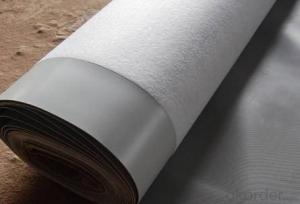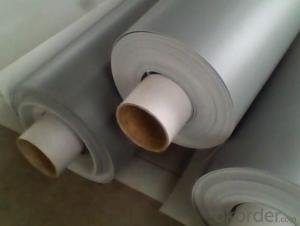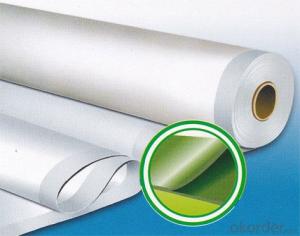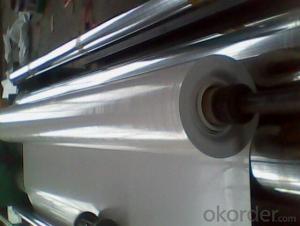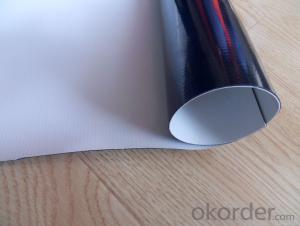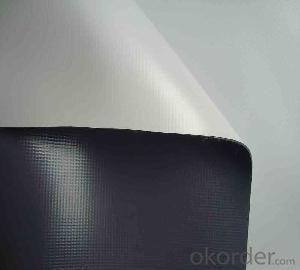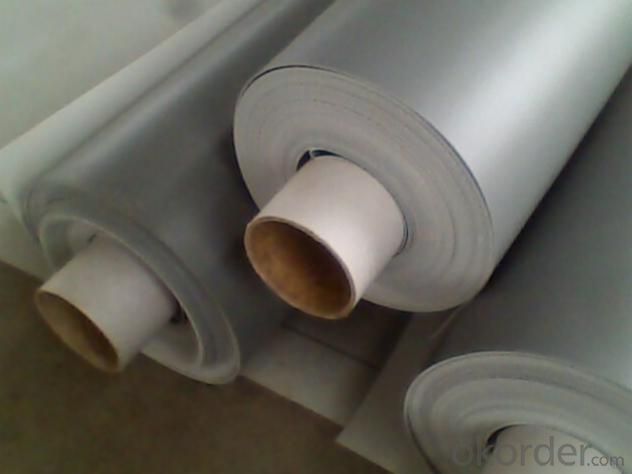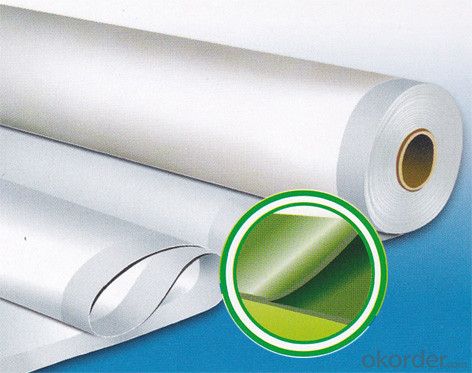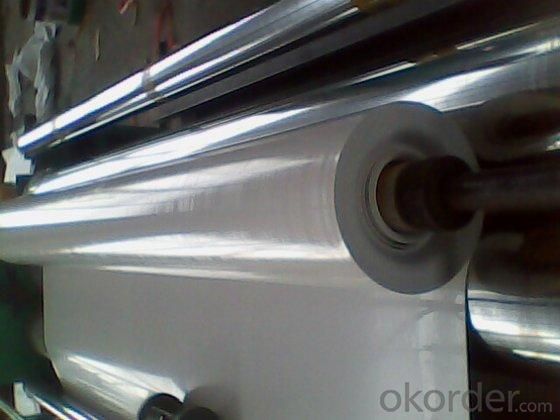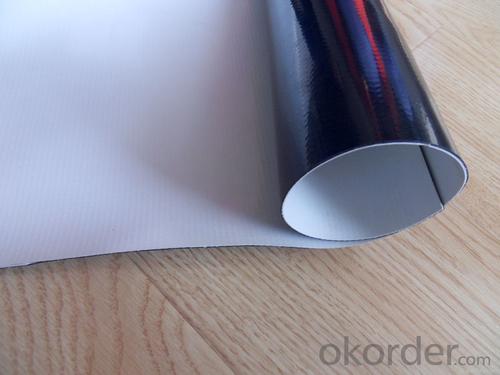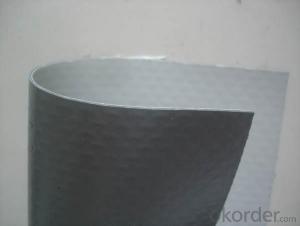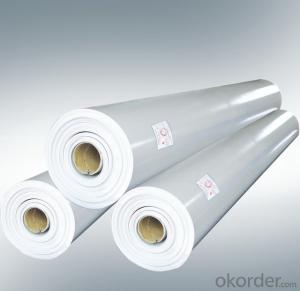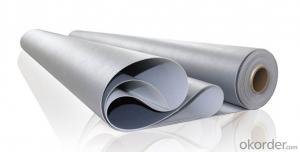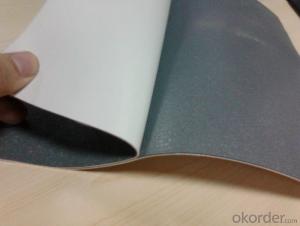PVC Waterproofing Membrane with Non-Compounded Layer
- Loading Port:
- Shanghai
- Payment Terms:
- TT OR LC
- Min Order Qty:
- 20000 m²
- Supply Capability:
- 5000000 m²/month
OKorder Service Pledge
OKorder Financial Service
You Might Also Like
PVC Waterproofing Membrane with Non-Compounded Layer
Product Description of PVC Waterproofing Membrane with Non-Compounded Layer:
PVC waterproofing membrane is an excellent high-quality polymer waterproof sheet, made of PVC resin by adding plasticizer, anti-UV agent, anti aging agent, and stabilizer and other processing aids through extrusion and molding. As the highly recommended product by the Ministry of Construction, it is featured by high tensile strength, great elongation, good stability, small shrinkage, low-temperature performances, good resistance to weathering and root
penetration, and long service life.
Features of PVC Waterproofing Membrane with Non-Compounded Layer:
1.Long service life and weathering resistance; and the materials can be used for 30 years on the roof and 50 years underground.
2. High tensile strength, great elongation, and small size change during heat treatment.
3. Good low temperature flexibility and adaptability to environmental temperature changes.
4. Good resistance to root penetration. It can be made for green roofs.
5. Excellent resistance to puncture and impact.
6. Convenient for construction (can be welded), solid and reliable, and Eco-friendly.
7. Strong resistance to chemical corrosion, suitable for special occasions.
8. Good plasticity, convenient and quick corner detail treatment. Easy maintenance and low cost.
9.After 2,000 hours of manual weathering verification
Classification of PVC Waterproofing Membrane with Non-Compounded Layer:
1. N: Homogeneous PVC membrane
2. L: PVC membrane with fabric backing
3. W: Reinforced PVC membrane
Advantage of PVC Waterproofing Membrane with Non-Compounded Layer:
1.) Mixing automation. Apply automatic temperature control automatic time control and automatic feed control.
2.) Extrusion equipment uses twin screw coextrusion. Screw temperature uses computer automatic temperature control system.
3.) Handpiece uses large width didhead extrusion equipment.
4.) Sophisticated three-roller calender equipment. The space between equiment is controlled by automation system.
Technical Data of PVC Waterproofing Membrane with Non-Compounded Layer:
No. | Item | Model Ⅱ | |
1 | Tensile Strength Mpa ≥ | 12.0 | |
2 | Elongation at break% ≥ | 250 | |
3 | Shrinkage rate % ≤ | 2.0 | |
4 | Flexibility at low temperature | No crackle at -25oC | |
5 | Water tightness | Watertight | |
6 | Puncture resistance | Watertight | |
7 | Heat aging treatment | Appearance | Free from bubble, crack, cohesion and void |
Change rate of tensile strength % | +20oC | ||
Change rate of elongation at break | |||
Flexibility at low temperature | No crack at -20oC | ||
8 | Chemical corrosion resistance | Change rate of tensile strength % | +20 |
Change rate of elongation at break | |||
Flexibility at low temperature | No crack at -20oC | ||
9 | Artificial weathering | Change rate of tensile strength % | +20 |
Change rate of elongation at break | |||
Flexibility at low temperature | No crack at -20oC | ||
Application of PVC Waterproofing Membrane with Non-Compounded Layer:
1) All kinds of roofs, such as steel structure roof, planted roof etc.
2) Underground engineering, such as building basement, subways, tunnels, air raid shelter, etc.
3) Other projects like artificial lake, dam, water reservoir, grain storehouse, etc.
Images of PVC Waterproofing Membrane with Non-Compounded Layer:
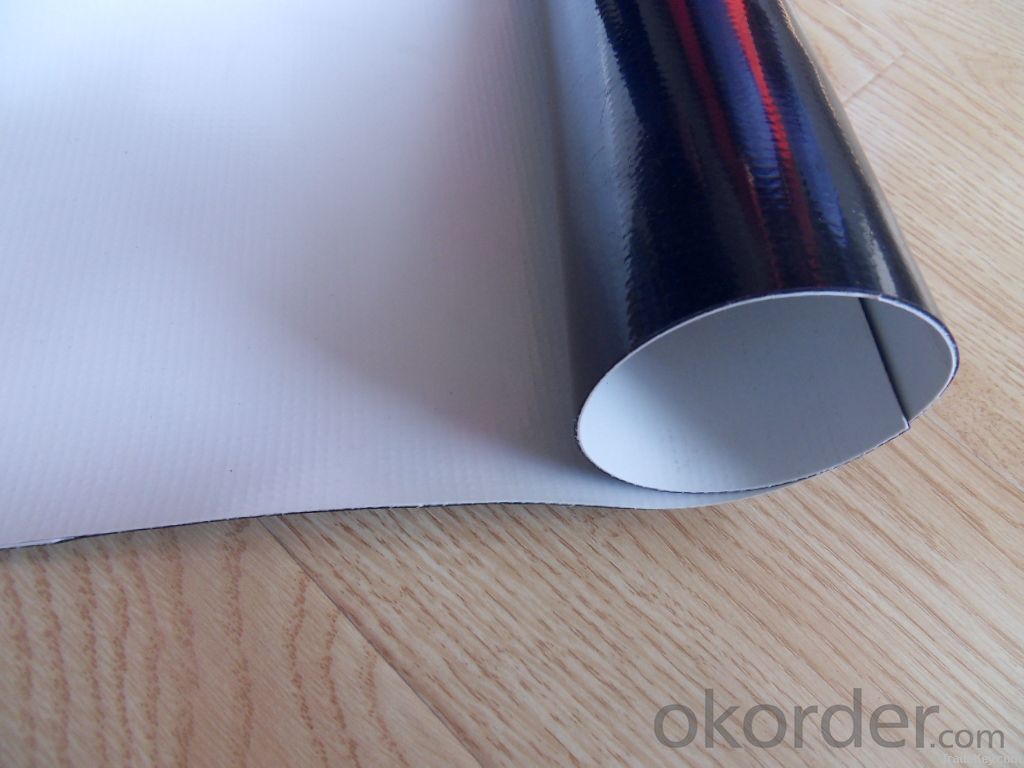
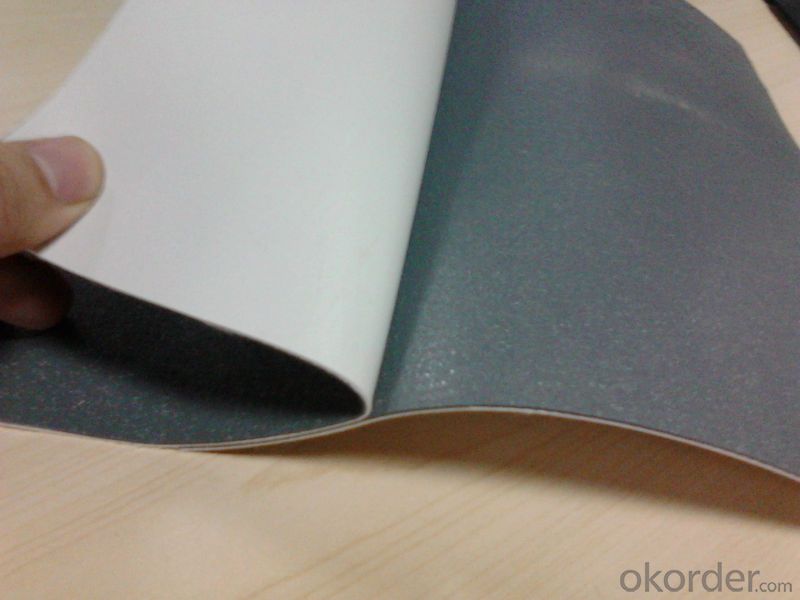
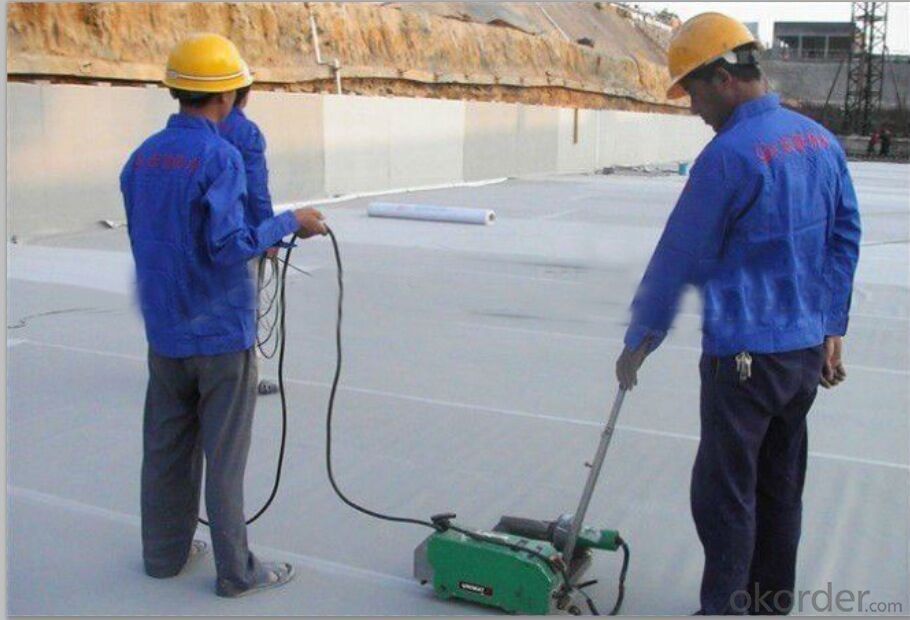
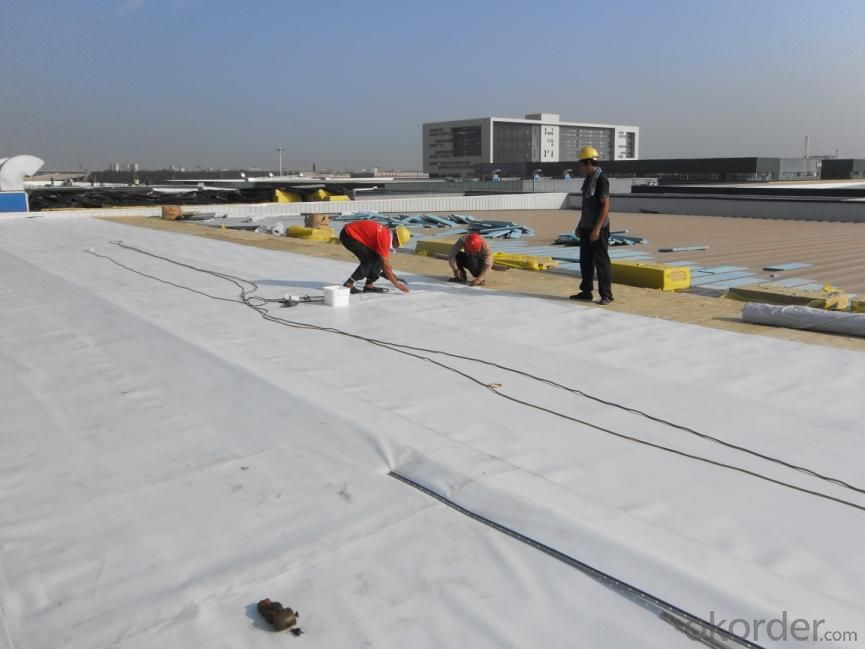
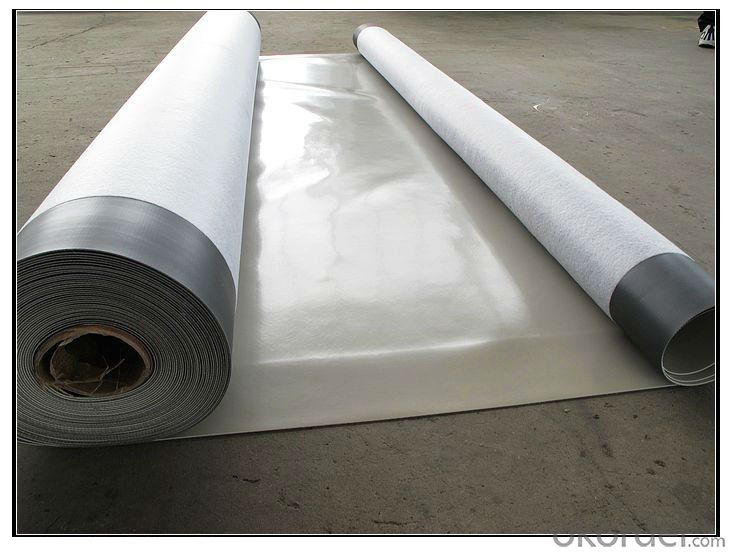
FAQ of PVC Waterproofing Membrane with Non-Compounded Layer:
1. Can you produce 4m width?
Yes, no problem for us. We have four bases in China, largest one in this field.
2. How many quantity in one 20'' container for 1.2mm and 1.5mm?
480rolls, 11520m2 for 1.2mm and 400rolls, 9600m2 for 1.5mm
3. Can you provide free samples?
Yes, our samples are free, but express fees usually on buyer's account.
- Q: Can a waterproofing membrane be used on precast concrete surfaces?
- Yes, a waterproofing membrane can be used on precast concrete surfaces. It helps to prevent water penetration and protect the concrete from moisture damage.
- Q: Can a waterproofing membrane be installed over existing coatings or sealants?
- Yes, a waterproofing membrane can be installed over existing coatings or sealants. However, it is important to assess the condition and compatibility of the existing coatings or sealants before installation to ensure proper adhesion and long-term performance of the waterproofing system.
- Q: How does a waterproofing membrane handle water infiltration from above?
- A waterproofing membrane handles water infiltration from above by creating a barrier that prevents water from seeping through the surface it is applied on. It effectively repels and redirects the water away, ensuring that it does not penetrate the underlying structure or cause any damage.
- Q: Are waterproofing membranes suitable for exterior use?
- Yes, waterproofing membranes are suitable for exterior use. These membranes are specifically designed to provide a barrier against water penetration and are commonly used in various exterior applications such as rooftops, balconies, and foundations. They are made from durable materials that can withstand exposure to harsh weather conditions, UV rays, and temperature fluctuations. Waterproofing membranes help to prevent water damage, moisture buildup, and potential structural issues caused by water infiltration. Additionally, they can be applied to different types of surfaces including concrete, metal, and wood, making them versatile for various outdoor environments. Overall, waterproofing membranes are a reliable solution for protecting exterior surfaces from water damage and prolonging their lifespan.
- Q: Can a waterproofing membrane be used on tunnels with ventilation systems?
- Yes, a waterproofing membrane can be used on tunnels with ventilation systems. In fact, it is commonly used to prevent water infiltration and protect the structure of the tunnel. The membrane is installed on the exterior walls and ceiling of the tunnel, ensuring that any water that may enter is diverted away from the tunnel and its ventilation system. This helps to maintain the integrity of the tunnel and ensures proper functioning of the ventilation system.
- Q: Can a waterproofing membrane be used for roofing?
- A waterproofing membrane is a suitable option for roofing and is commonly chosen for many roofing applications. Its purpose is to create a barrier that prevents water from infiltrating, thus preventing leaks and water damage on roofs. These membranes are typically made of durable materials like asphalt, synthetic rubber, or thermoplastic, which are resistant to water and can endure harsh weather conditions. They are installed on top of the roof surface, forming a seamless and watertight layer that keeps the interior of the building dry and safeguarded. Moreover, waterproofing membranes can be used on various types of roofs, including flat, sloped, and even green roofs. Ultimately, opting for a waterproofing membrane for roofing is an effective way to ensure long-lasting durability and protection against water damage.
- Q: Can a waterproofing membrane be used in shower pans?
- Yes, a waterproofing membrane can be used in shower pans. In fact, it is highly recommended to use a waterproofing membrane in shower pans to prevent any water leakage or damage to the underlying structure. A waterproofing membrane acts as a barrier, preventing water from seeping through the shower pan and into the subfloor or surrounding walls. This helps to maintain the integrity and longevity of the shower pan and the overall shower system. Additionally, a waterproofing membrane can also protect against mold and mildew growth, ensuring a safe and hygienic environment. Therefore, using a waterproofing membrane in shower pans is an essential step in ensuring a durable and water-resistant shower installation.
- Q: Are there any specific considerations for installing a waterproofing membrane on masonry surfaces?
- Yes, there are several specific considerations for installing a waterproofing membrane on masonry surfaces. Firstly, it is important to ensure that the masonry surface is clean and free from any dirt, debris, or loose materials that could compromise the adhesion of the membrane. Additionally, the surface should be properly prepared by repairing any cracks, holes, or damaged areas before applying the membrane. The type of waterproofing membrane chosen should be compatible with masonry surfaces and be able to withstand the movement and expansion that can occur. Proper installation techniques, such as ensuring sufficient overlap and proper sealing of joints, are also crucial to ensure effective waterproofing. Lastly, regular inspections and maintenance should be conducted to identify any potential issues and address them promptly.
- Q: Can a waterproofing membrane be used on retaining walls?
- Using a waterproofing membrane on retaining walls is possible. Retaining walls often face moisture and hydrostatic pressure, which can result in water infiltration and structural decay. By applying a waterproofing membrane to the retaining wall, water penetration can be prevented, shielding the wall from moisture-related harm and extending its lifespan. The membrane acts as a barrier, stopping water from seeping into the wall and causing problems like efflorescence, cracks, or erosion. It is crucial to select a waterproofing membrane that is designed specifically for below-grade applications and can withstand the pressure exerted by the soil being retained. Moreover, proper installation techniques and suitable drainage systems should be taken into account to ensure the effectiveness of the waterproofing membrane on retaining walls.
- Q: Can a waterproofing membrane be used for a hotel swimming pool area?
- Indeed, a hotel swimming pool area can benefit greatly from the utilization of a waterproofing membrane. Functioning as a specially engineered substance, this membrane is applied to surfaces with the purpose of impeding water penetration. By creating a protective barrier, it effectively prevents water from infiltrating the underlying structure, thereby safeguarding it against potential water-related harm. In the case of a hotel swimming pool area, the application of a waterproofing membrane to both the pool shell and its surroundings serves the purpose of averting any water leakage into the building or adjacent structures. This proactive measure not only ensures the preservation of the pool area's integrity but also precludes the occurrence of any potential water damage. Furthermore, the implementation of a waterproofing membrane also effectively inhibits the development of mold and mildew by establishing a moisture barrier. Hence, opting to employ a waterproofing membrane for a hotel swimming pool area is an astute decision that guarantees the pool and its surrounding structures' longevity and durability.
Send your message to us
PVC Waterproofing Membrane with Non-Compounded Layer
- Loading Port:
- Shanghai
- Payment Terms:
- TT OR LC
- Min Order Qty:
- 20000 m²
- Supply Capability:
- 5000000 m²/month
OKorder Service Pledge
OKorder Financial Service
Similar products
Hot products
Hot Searches
Related keywords
